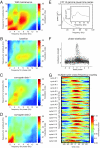Cross-frequency coupling supports multi-item working memory in the human hippocampus
- PMID: 20133762
- PMCID: PMC2840289
- DOI: 10.1073/pnas.0911531107
Cross-frequency coupling supports multi-item working memory in the human hippocampus
Abstract
Recent findings indicate that the hippocampus supports not only long-term memory encoding but also plays a role in working memory (WM) maintenance of multiple items; however, the neural mechanism underlying multi-item maintenance is still unclear. Theoretical work suggests that multiple items are being maintained by neural assemblies synchronized in the gamma frequency range (25-100 Hz) that are locked to consecutive phase ranges of oscillatory activity in the theta frequency range (4-8 Hz). Indeed, cross-frequency coupling of the amplitude of high-frequency activity to the phase of slower oscillations has been described both in animals and in humans, but has never been linked to a theoretical model of a cognitive process. Here we used intracranial EEG recordings in human epilepsy patients to test pivotal predictions from theoretical work. First, we show that simultaneous maintenance of multiple items in WM is accompanied by cross-frequency coupling of oscillatory activity in the hippocampus, which is recruited during multi-item WM. Second, maintenance of an increasing number of items is associated with modulation of beta/gamma amplitude with theta band activity of lower frequency, consistent with the idea that longer cycles are required for an increased number of representations by gamma cycles. This effect cannot be explained by a difference in theta or beta/gamma power. Third, we describe how the precision of cross-frequency coupling predicts individual WM performance. These data support the idea that working memory in humans depends on a neural code using phase information.
Conflict of interest statement
The authors declare no conflict of interest.
Figures




References
-
- Baddeley A. Working memory. Science. 1992;255:556–559. - PubMed
-
- Herrmann C-S, Munk M-H, Engel A-K. Cognitive functions of gamma-band activity: Memory match and utilization. Trends Cogn Sci. 2004;8:347–355. - PubMed
-
- Fries P. A mechanism for cognitive dynamics: Neuronal communication through neuronal coherence. Trends Cogn Sci. 2005;9:474–480. - PubMed
-
- Howard M-W, et al. Gamma oscillations correlate with working memory load in humans. Cereb Cortex. 2003;13:1369–1374. - PubMed
Publication types
MeSH terms
LinkOut - more resources
Full Text Sources
Other Literature Sources
Molecular Biology Databases

